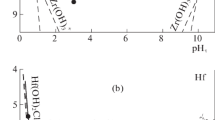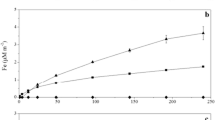Abstract
Hydroxy-carboxylic acids inhibit the crystallization of ferrihydrite in the pH range 9–11 in the order
and favor hematite formation relative to goethite in the order
The crystal shape of hematite can change from hexagonal plates to acicular in the presence of these acids. The influence of the acids on the crystallization rises with increasing concentration and with falling pH.
The effectiveness in suppressing crystallization depends on whether and how strongly the acid adsorbs on ferrihydrite and how strongly it complexes with Fe3+ in solution. Inhibition of crystallization of hematite is believed to be due to the di- and tricarboxylic acid linking ferrihydrite particles in an immobile network. Goethite formation is suppressed by the acid complexing with Fe in solution and hindering nucleation; strongly adsorbing acids also adsorb on the nuclei and hinder further growth. Certain acids can induce hematite formation because they contain a group which acts as a template for nucleation of hematite.
Резюме
Гидрокси-карбоксильные кислоты препятствуют кристаллизации ферригидрита в диапазоне рН 9–11 в порядке  и способствуют образованию гематита относительно гетита в порядке
и способствуют образованию гематита относительно гетита в порядке  Кристаллическая форма гематита может быть изменена вследствие присутствия этих кислот. Влияние этих кислот на кристаллизацию увеличивается с увеличением концентрации кислоты и с уменьшающейся рН.
Кристаллическая форма гематита может быть изменена вследствие присутствия этих кислот. Влияние этих кислот на кристаллизацию увеличивается с увеличением концентрации кислоты и с уменьшающейся рН.
Эффективность в подавлении кристаллизации зависит от того, в какой степени кислота адсорбируется ферригидритом и насколько прочные комплексы с Ре3+ она образует в растворе. Предполагается, что кристаллизация гематита затрудняется благодаря связыванию двух- и трех-карбоксильной кислотой ферригидритных частиц в неподвижное соединение. Образование гетита подавляется кислотой, соединяющейся с Ре в растворе и препятствующей образованию ядер кристаллизации; сильно адсорбирующие кислоты также адсорбируются ядрами и препятствуют их дальнейшему росту. Некоторые кислоты могут вызвать образование гематитов потому что они содержат группу, которая способствует образованию центров кристаллизации гематита.
Resümee
Verschiedene Hydroxycarbonsäuren verhindern die Kristallisation des Ferrihydrits zu Goethit und Hämatit im pH-Bereich 9–11 in der Reihenfolge
und begünstigen Hämatit auf Kosten von Goethit in der Reihenfolge
Der Säureeinfluß steigt mit steigender Konzentration und fallendem pH. In Gegenwart der Säuren sind die Hämatitkristalle nicht sechseckig sondern leistenförmig.
Die Unterdrückung der Kristallisation hängt davon ab, wie stark die Säure vom Ferrihydrit adsorbiert wird und wie stark sie das Fe3+ in der Lösung komplexiert. Es wird angenommen, daß die Kristallisation des Hämatits dadurch verhindert wird, daß die organischen Anionen die Ferrihydritteilchen zu einem starren Netzwerk verknüpfen. Die Goethitbildung wird dagegen durch Komplexierung des Fe und Verhinderung der Keimung bzw. des Kristallwachstums gestört. Einige Säuren wirken als “Schablone” fördernd auf die Kristallisation des Hämatits.
Résumé
Les acides hydroxy-carboxyliques inhibent la cristallisation de ferrihydrite sur une étendue de pH de 9 à 11 dans l’ordre
et favorisent la formation d’hématite pas rapport à la goethite dans l’ordre
La forme en crystal de l’hématite peut être modifiée par la présence de ces acides. L’influence de ces acides sur la cristallisation croît proportionellement à l’accroissement de la concentration d’acide et au décroisse-ment du pH.
L’efficacité de suppression de la cristallisation dépend de ce que, et comment l’acide adsorbe sur la ferrihydrite et de quel degré il se complexe avec Fe3+ en solution. On croit que l’inhibition de la cristallisation de l’hematite est due à l’acide di- et tricarboxylique liant des particules de ferrihydrite dans un entremeshement immobile. La formation de goethite est réprimée par l’acide se complexant avec Fe en solution et empêchant la nucléation; ces acides fortement adsorbants adsorbent aussi sur les noyaux et empêchent tout accroissement ultérieur. Certains acides peuvent induire la formation d’hématite parce-qu’ils contiennent un groupe qui agit comme moule pour la nucléation de l’hématite.
Similar content being viewed by others
References
Fischer, W. R. and Schwertmann, U. (1975) The formation of hematite from amorphous iron(III) hydroxide: Clays & Clay Minerals 23, 33–37.
Kitano, Y. and Hood, D. W. (1965) The influence of organic material on the polymorphic crystallization of calcium carbonate: Geochim. Cosmochim. Acta 29, 29–41.
Kodama, H. and Schnitzer, M. (1977) Effect of fulvic acid on the crystallization of Fe(III) oxides: Geoderma 19, 279–291.
Lewis, D. G. and Schwertmann, U. (1979) The influence of aluminum on the formation of iron oxides. IV. The influence of [Al], [OH], and temperature: Clays & Clay Minerals 27, 195–200.
Parfitt, R. L., Farmer, V. C, and Russell, J. D. (1977) Adsorption on hydrous oxides. I. Oxalate and benzoate on goethite: J. Soil Sci. 28, 29–39.
Robert, M. and Karimi, M. (1975) Altération des micas et géochimie de l’aluminium, rôle de la configuration de la molécule organique sur l’aptitude et la complexation: C. R. Acad. Sci. Paris Sér. D 280, 2645–2648.
Schwertmann, U. (1964) Differenzierung der Eisenoxide des Bodens durch Extraktion mit einer Ammoniumoxalat-Lösung: Z. Pflanzenernähr. Düng. Bodenkd. 105, 194–202.
Schwertmann, U. (1966) Inhibitory effect of soil organic matter on the crystallization of amorphous ferric hydroxide: Nature 212, 645–646.
Schwertmann, U. (1969) Der Einfluß einfacher organischer Anionen auf die Bildung von Goethit und Hämatit aus amorphem Fe(III)-hydroxid: Geoderma 3, 207–214.
Schwertmann, U. and Fischer, W. R. (1966) Zur Bildung von α-FeOOH und α-Fe2O3 aus amorphem Eisen(III)-hydroxid. III. Z. Anorg. Allg. Chem. 346, 137–142.
Schwertmann, U. and Fischer, W. R. (1973) Natural “amorphous” ferric hydroxide: Geoderma 10, 237–247.
Schwertmann, U., Fischer, W. R., and Papendorf, H. (1968) The influence of organic compounds on the formation of iron oxides: Trans. 9th Int. Congr. Soil Sci. Adelaide 1, 645–655.
Sillen, L. G. and Martell, A. E. (1964) Stability constants of metal ion complexes. Chem. Soc. London. Spec. Publ. No. 17. pp. 390, 470.
Towe, K. W. and Bradley, W. F. (1967) Mineralogical constitution of colloidal hydrous ferric oxides: J. Colloid Interface Sci. 24, 384–392.
Author information
Authors and Affiliations
Rights and permissions
About this article
Cite this article
Cornell, R.M., Schwertmann, U. Influence of Organic Anions on the Crystallization of Ferrihydrite. Clays Clay Miner. 27, 402–410 (1979). https://doi.org/10.1346/CCMN.1979.0270602
Received:
Accepted:
Published:
Issue Date:
DOI: https://doi.org/10.1346/CCMN.1979.0270602




